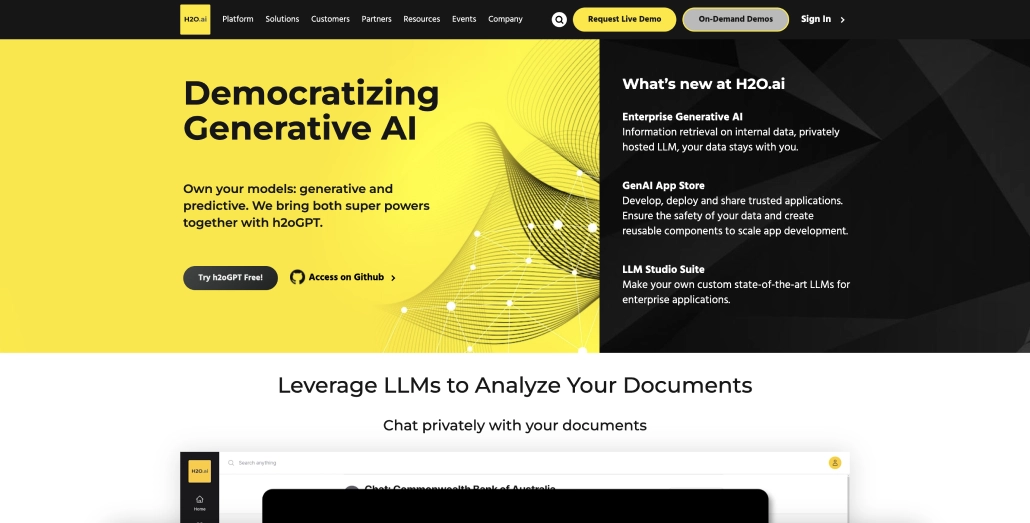In a nutshell:
- Predictive AI software offers proven results for businesses, unlike passing tech fads.
- User-friendly platforms like Pecan enable non-coders to harness predictive AI.
- Consider factors like technical expertise, project requirements, and budget when choosing predictive AI software.
- Platforms like Pecan, H2O.ai, and DataRobot offer unique strengths and weaknesses for different user needs.
- Evaluate key criteria to select the best predictive AI software for your business and career.
The tech world throws a lot of shiny objects our way: generative AI today, augmented reality tomorrow. But businesses need more than passing fads — they need results. The reality is any new technology needs to be paired with proven performers to deliver results. That's where predictive AI software steps in.
Unlike the flavor-of-the-year tech trends, predictive AI software is a business-tested veteran (since the 1940s, no less!) with countless applications across industries. Predicting customer churn? Optimizing supply chains? Predictive AI helps analysts tackle it all.
This guide is your roadmap to harnessing this technology. We'll show you how to choose the perfect platform (spoiler alert: coding isn’t always required!), explore the diverse use cases of predictive AI software, and maximize its strategic impact on your daily analytics and career. Ready to transform your data from headache to strategic weapon?
Using powerful predictive AI software without code
The world of predictive AI software was once this exclusive club for R and Python experts. Today, that’s not the case. Cloud-based platforms make it easier than ever for analysts and teams to deploy, use, and garner valuable insights from predictive AI software — even without extensive coding experience.
Imagine enabling not just yourself — but your entire company to access insights and make truly data-driven decisions. Sounds pretty cool, right?
Here’s how these platforms work: They come pre-loaded with building blocks like common data processing steps and prebuilt algorithms. They also automate large portions of the modeling process, streamlining workflows and even minimizing errors that could actually be caused by manual coding.
And to top it all off, many of these platforms offer seamless data integration with popular sources. This ensures a smooth flow of information from raw data to actionable insights derived from your predictive AI software.
Let’s get into some of the ways you can create predictive AI models:
1. No-code/Low-code Platforms
Platforms like Pecan improve the accessibility of predictive AI software. These user-friendly platforms embrace a no-code/low-code approach, empowering users to build sophisticated models through natural language interfaces, drag-and-drop elements, and visual workflows. This eliminates the need for extensive programming expertise, making predictive AI software available to a wider range of users.
There are many advantages to low-code predictive AI solutions
2. AutoML solutions
Automated machine learning (AutoML) tools, frequently found within cloud AI platforms, handle the heavy lifting of algorithm selection, hyperparameter tuning, and model optimization. Essentially, you provide the data, and the AutoML tool finds the best-performing model for your use case.
3. Pre-trained models
These models come pre-trained on vast datasets and can be fine-tuned to your specific use case, offering a significant head start in model development. Many cloud AI platforms host marketplaces of pre-trained models across different domains.
In summary: This shift toward user-friendly AI development is a game-changer. It democratizes access to AI, enabling analysts like you across industries to make data-driven predictions with AI — and actually minimize operational hiccups and manual tasks. By streamlining the entire AI development process, from data preparation and model training to deployment and monitoring, you can quickly tap into predictive AI and begin building impactful models that address your business’s specific needs.
Why a low-code approach to predictive AI software works
The benefits of predictive AI tools extend beyond ease of use. Cloud platforms like Pecan offer a cost-effective approach to model development. By leveraging the cloud's vast computing power and prebuilt infrastructure, your business can avoid the significant cost typically associated with on-premises servers or AI tool development. Additionally, these platforms often come with built-in scalability, allowing models to adapt and evolve as data volumes and business needs change.
There’s also the speed factor. Without having to build predictive AI software and models from scratch (talk about a lengthy process), user-friendly platforms mean you can build and deploy predictive models faster, allowing you to iterate and gain valuable insights in shorter time frames. It also puts predictive AI software in the hands of non-data scientists.
Speed of AI implementation is a significant criterion when evaluating AI solutions.
So, you can deemphasize the need to learn Python and R while capitalizing on your analytics know-how and strategic thinking, helping your business make more data-driven decisions and making yourself look like an all-star in the process.
Choosing the best predictive AI software for you
With the evolution of predictive AI modeling tools, more analysts can feel empowered to use AI to meet their business goals. If you haven't explored these platforms yet, what are you waiting for?!
This section will provide an overview of some top options, highlighting their strengths and weaknesses to help you choose the one that best suits your needs.
Best Predictive AI Software Option #1: Pecan AI
Best Predictive AI Software Option #1: Pecan
Pecan is a tour de force in the world of predictive AI software, designed to empower a wide range of users, not just seasoned data scientists. Through its user-friendly cloud platform, Pecan breaks down barriers with a drag-and-drop interface and a unique concept called Predictive GenAI. This translates to the removal of manual analysis and model building through a text-based interface and prebuilt components and workflows.
How Pecan excels:
- Ease of Use: Data-driven professionals can use its intuitive interface to build, iterate on, and deploy models.
- Predictive GenAI leader: Pecan makes it easy to define models and fine-tune them using natural language, eliminating guesswork and manual coding.
- Versatility across industries: There’s flexibility to apply AI to a wide range of business challenges, and the Predictive Chat will help you customize your model to your specific need.
- Cost-Effective Solution: The pay-as-you-go pricing model makes it a budget-friendly option for businesses of all sizes.
Where Pecan falls short:
- Tailored control or complex models: Pecan might not cater to highly specialized models requiring very granular control over every aspect of the development process.
- Coding customization: Pecan only uses SQL.
H2O.ai
Best Predictive AI Software Option #2: H2O.ai
H2O takes a slightly different approach, offering an open-source platform with a focus on interpretability. This means you have access to the underlying code (beyond SQL) and can understand how your models arrive at their predictions.
How H2O excels:
- Open-source and customizable: Allows for deeper customization compared to some closed platforms.
- Focus on interpretability: Understanding how your models make predictions can be crucial for building trust and ensuring fairness.
- Large community and resources: Benefit from an online community and readily available resources for support and learning.
Where H2O falls short:
- Steeper learning curve: Requires more technical expertise and coding knowledge.
- Limited cloud integration: Integration with specific cloud providers might not be as seamless as some competitors that are more universal.
DataRobot
Best Predictive AI Software Option #3: DataRobot
DataRobot is a well-known option that automates the machine learning workflow for businesses to build and deploy models quickly with minimal coding.
How DataRobot excels:
- Automation-centric: Streamlines the entire model-building process, accelerating development and deployment.
- Ease of use: Caters to a broad range of users, though some technical knowledge will help.
- Prebuilt model library: Offers a large selection of prebuilt models to jumpstart projects.
Where DataRobot falls short:
- Limited customization: Focus on automation comes at the expense of some customization options compared to more open platforms.
- Vendor lock-in: Proprietary environment might limit flexibility for businesses heavily invested in other cloud platforms.
Google Cloud and Vertex AI
Best Predictive AI Software Options #4-6: The Tech Giant Cloud Platforms
While Google, Amazon, and Microsoft dominate the tech landscape, their offerings in predictive AI software cater more to experienced users. These industry titans—Google Cloud Vertex AI, Amazon SageMaker, and Microsoft Azure—have mega sets of features and functionalities for data scientists and developers to build complex models.
However, these comprehensive suites could come with a trade-off: accessibility. Their extensive functionalities can be overwhelming for beginners navigating the world of AI development for the first time. Additionally, a potential pitfall is vendor lock-in. By choosing a platform from a major cloud provider, you might become reliant on their specific cloud ecosystem and potentially other tools within that ecosystem, even though they may not be best-in-class or fit your specific needs.
Before you buy: Questions to help guide your decision
The key to unlocking the power of predictive AI software lies in choosing the platform that aligns perfectly with your business's needs and your skill sets. It’s not an easy decision, so here are some key questions to keep in mind:
- Technical expertise: What is your comfort level with coding and complex software environments?
- Project requirements: Do you need a highly customizable platform for intricate models, or are you prioritizing rapid prototyping and ease of use?
- Data volume: How much data are you working with, and how much can this platform handle?
- Budget: What are the pricing models? Does this align with your team’s financial resources?
- Existing cloud infrastructure: Are you already heavily invested in a specific cloud provider’s ecosystem?
- Free trial: Does this predictive AI software vendor offer a free trial so you can explore its fit?
By carefully evaluating these criteria, you'll be well-equipped to select the best predictive AI software for your business and career.
Ready to take the next step in your analytics? Get a personalized demo of Pecan and discover how its functionalities can help you build impactful predictive AI models that drive strategic success. Sign up for a free trial today and experience the power of accessible AI firsthand!









